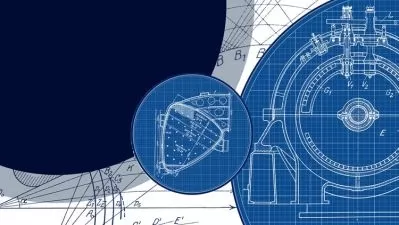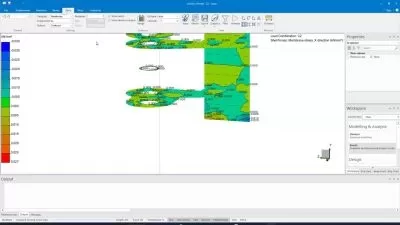Anatomy of Maintenance Equipment: Cranes
Atul Singla
4:14:42
Description
Types of crane, Pros & Cons, Working Principle, Operational steps of crane
What You'll Learn?
- Crane Anatomy and Maintenance Fundamentals: Mobile & Tower Cranes
- Types, Functions, Anatomy of Mobile Crane Components & Role in Mobile Crane operation
- Types, Functions, Anatomy of Tower Crane Components & Role in Tower Crane operation
- Types, Functions, Anatomy, Working Principle of Overhead Crane Components
- Types, Functions, Anatomy, Working Principle of Jib Crane Components
- Types, Functions, Anatomy, Working Principle of Floating Crane Components
Who is this for?
More details
DescriptionMaintenance equipment in the oil and gas industry can include a variety of tools, machinery, and vehicles used to maintain and repair oil and gas production facilities, pipelines, and other equipment. Some common examples of maintenance equipment used in the oil and gas industry include:
1.Welding equipment - used to weld and repair pipelines and other metal structures
2.Compressors - used to power pneumatic tools for maintenance and repair work
3.Generators - used to provide power in remote locations or in the event of power outages
4. Pressure testing equipment - used to test the integrity of pipelines and other equipment
5.Inspection tools - including cameras, sensors, and other devices used to inspect the condition of equipment and identify potential issues
6.Cranes and lifting equipment - used to move heavy equipment and components during maintenance and repair work.
These are just a few examples of the many types of maintenance equipment used in the oil and gas industry. The specific equipment used can vary depending on the type of facility, the equipment is maintained, and other factors.
The following cranes have been covered in this course
1.Mobile cranes: versatile and transportable, used for lifting heavy equipment and materials during maintenance operations
2.Tower cranes: tall and stationary, used for maintenance tasks in construction projects, capable of lifting heavy equipment to great heights
3.Overhead cranes: fixed and mounted on a beam or gantry, useful for lifting heavy equipment or machinery in limited floor space environments
4.Jib cranes: small and portable, used for lifting equipment and materials in confined spaces
5.Floating cranes: mounted on barges, used for maintenance tasks in offshore oil and gas platforms, capable of lifting heavy equipment and materials from the platform to the barge for transportation to shore
This Maintenance Equipment course provides a comprehensive understanding of various maintenance equipment used in industrial settings. The course covers the different types of maintenance equipment, their critical components, advantages, and disadvantages, as well as their working principle and operational steps.
Course Objectives: Upon completion of this course, participants will be able to:
Understand the types of maintenance equipment and their applications
Identify the critical components of maintenance equipment
Evaluate the pros and cons of different maintenance equipment
Understand the working principle of different maintenance equipment
Identify the operational steps for different maintenance equipment
Course Topics: The course covers the following topics:
Introduction to Maintenance Equipment
Types of Maintenance Equipment: mechanical, electrical, hydraulic, pneumatic, and electronic
Critical Components of Maintenance Equipment: motors, pumps, gears, bearings, valves, sensors, controllers, and actuators
Pros and Cons of Different Maintenance Equipment: cost, reliability, maintenance requirements, and ease of use
Working Principle of Different Maintenance Equipment: principles of operation, power source, and control mechanisms
Operational Steps for Different Maintenance Equipment: maintenance procedures, troubleshooting, and repair
Who this course is for:
- Those who are willing to learn
Maintenance equipment in the oil and gas industry can include a variety of tools, machinery, and vehicles used to maintain and repair oil and gas production facilities, pipelines, and other equipment. Some common examples of maintenance equipment used in the oil and gas industry include:
1.Welding equipment - used to weld and repair pipelines and other metal structures
2.Compressors - used to power pneumatic tools for maintenance and repair work
3.Generators - used to provide power in remote locations or in the event of power outages
4. Pressure testing equipment - used to test the integrity of pipelines and other equipment
5.Inspection tools - including cameras, sensors, and other devices used to inspect the condition of equipment and identify potential issues
6.Cranes and lifting equipment - used to move heavy equipment and components during maintenance and repair work.
These are just a few examples of the many types of maintenance equipment used in the oil and gas industry. The specific equipment used can vary depending on the type of facility, the equipment is maintained, and other factors.
The following cranes have been covered in this course
1.Mobile cranes: versatile and transportable, used for lifting heavy equipment and materials during maintenance operations
2.Tower cranes: tall and stationary, used for maintenance tasks in construction projects, capable of lifting heavy equipment to great heights
3.Overhead cranes: fixed and mounted on a beam or gantry, useful for lifting heavy equipment or machinery in limited floor space environments
4.Jib cranes: small and portable, used for lifting equipment and materials in confined spaces
5.Floating cranes: mounted on barges, used for maintenance tasks in offshore oil and gas platforms, capable of lifting heavy equipment and materials from the platform to the barge for transportation to shore
This Maintenance Equipment course provides a comprehensive understanding of various maintenance equipment used in industrial settings. The course covers the different types of maintenance equipment, their critical components, advantages, and disadvantages, as well as their working principle and operational steps.
Course Objectives: Upon completion of this course, participants will be able to:
Understand the types of maintenance equipment and their applications
Identify the critical components of maintenance equipment
Evaluate the pros and cons of different maintenance equipment
Understand the working principle of different maintenance equipment
Identify the operational steps for different maintenance equipment
Course Topics: The course covers the following topics:
Introduction to Maintenance Equipment
Types of Maintenance Equipment: mechanical, electrical, hydraulic, pneumatic, and electronic
Critical Components of Maintenance Equipment: motors, pumps, gears, bearings, valves, sensors, controllers, and actuators
Pros and Cons of Different Maintenance Equipment: cost, reliability, maintenance requirements, and ease of use
Working Principle of Different Maintenance Equipment: principles of operation, power source, and control mechanisms
Operational Steps for Different Maintenance Equipment: maintenance procedures, troubleshooting, and repair
Who this course is for:
- Those who are willing to learn
User Reviews
Rating
Atul Singla
Instructor's Courses
Udemy
View courses Udemy- language english
- Training sessions 49
- duration 4:14:42
- Release Date 2023/04/25


























